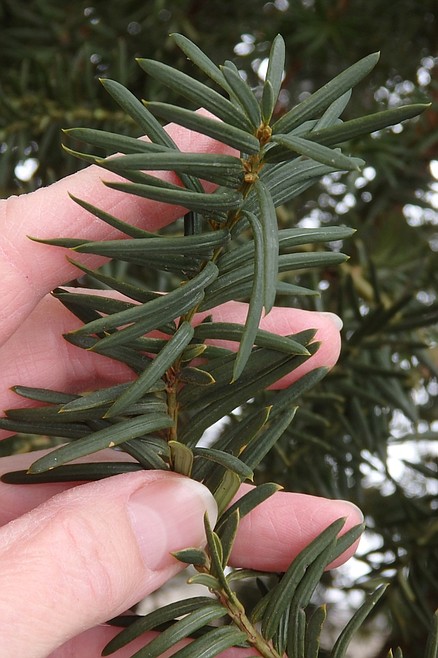Shrub responsible for wildlife deaths
Bonner County Daily Bee | UPDATED 7 years, 10 months AGO
A couple of weeks ago I received a phone call from special pal and former co-worker at the Bee, Betty Johnson. After a bit of “catching-up” she told me the reason for her call. She had been watching a female moose browsing the shrubs in her yard and suddenly noticed that it had begun tossing its head about and shaking its head and ears — staggering about and then seemingly becoming angry and making hostile “charges” toward the house. After a time, with no let-up in the creature’s actions, Betty called Matt Haag at Idaho Fish & Game and explained the moose’s behavior to him. Bless his heart, he actually went to her house to observe! The moose lay down briefly and Matt ascertained that she was pregnant, and after checking the bushes she’d been eating, established that they were Japanese Yew (Taxus custidata).
Matt told Betty that the popular shrubs were toxic to all members of the deer family — as well as other browsing animals as well, and were responsible for the deaths of both deer and moose locally and elsewhere across the state, including an entire herd of 20-30 elk!
He said if the moose at hand was poisoned its calf would die, too.
He said F&G had been trying to get the word out about the situation but hadn’t made much headway. Betty said, “How about calling Valle?” He agreed with that and gave her his number for me to call.
Meanwhile, the sick moose had gotten up and wandered next door to a huge snow-pile and began eating the snow in great gulps. It seemed to revive it a bit, and it’s hoped that the moose will recover.
My following conversation with Matt provided the alarming statistics furnished earlier, and he stressed the fact that while the imported Japanese Yew is deadly, its soft-needled branches and bright red berries are pretty and appealing. He pointed out that little children might covet those pretty but poisonous berries and their seeds — which incidentally are toxic to many other creatures.
The native Pacific Yew (Taxus brevifolia) is perfectly safe for use (a call to native plant wizard Bob Wilson of Cedar Mt. Perennials provided me with the Latin name) and it should be used to replace the seemingly popular Japanese Yew.
Matt Haag is hopeful that people with the dangerous plants will remove them — or at least cover them with burlap to discourage foragers.
For further information, readers should call the Idaho Department of Fish and Game at Coeur d’Alene, 208-769-1414. Nursery owners reading this should consider returning or disposing of their stock, and notify suppliers of the problem.
Fortunately, other possibilities abound as substitutes; The attractiveness and practicality of Pachistma — variously known as Oregon box or Mountain Lover — boasts year-round bright/dark green, shiny, toothed leaves and is a sure bet for best all-around shrub.
It is what I call a “sifter” plant; with tangled branches and the supple, leathery leaves, it allows winter snowfall entry to its base rather than collecting atop and crushing it. Too, consider Mugho and other dwarf Pines, and many members of the Juniperus family.
Native Rocky Mountain Juniper for its loose-limbed, cedar-like foliage and dusky blue berries is a standout. Hybrids, such as the Procumbens group, spread out from a mounded form with an almost moss-like foliage that is green in spring and summer but becomes tinged with purple during winter.
Tsuga Canadensis — hemlock - is another great creeper, hardy to Zone 2. T “Jeddaloah”, a dwarf conifer, cascades arching branches down embankments, over rocks and across the lawn if you let it. T. Cole’s Prostrate” spreads out dark green branches into a literal ground-cover that grows only a few inches high.
Small weeping evergreens like Norway Spruce are winners as well; my beautiful specimen bends double over itself and spreads it’s curved branches along the ground like some grand lady’s skirts. (However, I’ve named this one “Old Man of the Mountains” after my beloved Daddy — who, I am sure, visits me often there in spirit).
Cotoneaster, with its deep green red berry-covered boughs is a prolific grower here, with several varieties available.
The branches can grow in an attractive “fan” or trail to the ground, depending on which one you choose. Like Pachystima, it is a great sifter, providing its own protective support. I actually had to prune mine back — it had become so large it had taken over a 6-foot by18-foot bed! Found all sorts of forgotten beauties huddled underneath those encroaching branches. This would also be the perfect shrub for an embankment — as would many others herein mentioned.
Valle Novak writes the Country Chef and Weekend Gardener columns from the Daily Bee. She can be reached at bcdailybee@bonnercountydailybee.com.




